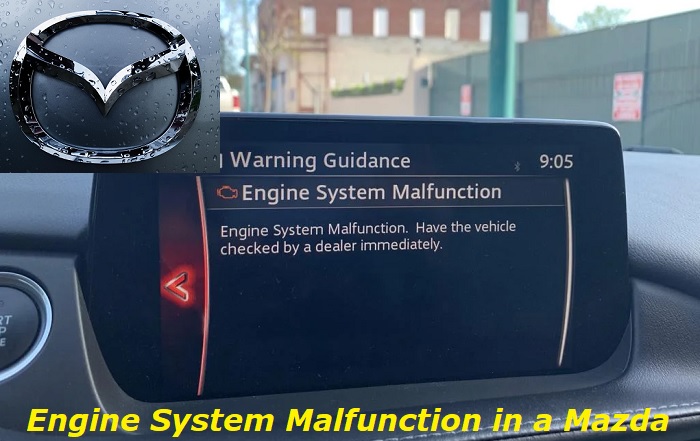It can be really frustrating when that little light on your Mazda's dash comes on, indicating an "Engine System Malfunction". But what does this actually mean?
Engine system malfunction message highlights
- Common reasons:issues with any engine sensor or other electronics-related problem
- How to fix:read the codes to understand the issue
- Possible consequences:depending on the actual problem
- Priority level:High
- Can you drive?Carefully
- DIY repair:Possible
- Repair price range:$100-$350

Common Problems Attributed to the "Engine System Malfunction" Warning in Mazda Cars
The "Engine System Malfunction" error can cause a variety of problems for your car. Making it worse is the fact that searching for the root of the problem can be complicated at times because the warning is not only confined to the internal components of your engine, but it may also include any other components linked to it.
1. Faulty Spark Plugs
If your spark plugs are worn out or damaged, they can cause misfires in your engine which will trigger the light. Symptoms of this problem include a drop in fuel economy, a decrease in power, a hard start, and your engine may run rough or stall. To fix this problem, you will need to replace your spark plugs.
Assuming you have the right tools for the job, replacing a spark plug on a Mazda car is actually a pretty straightforward process. Start by disconnecting the negative battery terminal. This will help prevent any accidental electrical shocks.
Next, locate the spark plug you need to replace. On most Mazda models, the spark plugs are near the front of the engine, on either side. Using a spark plug socket and ratchet, loosen the spark plug until it can be turned by hand.
Carefully remove the spark plug, being mindful not to drop it or damage the threads. Inspect the spark plug to see if it needs to be replaced. If it's damaged or fouled, it will need to be replaced.
To install the new spark plug, simply thread it into the hole by hand. Once it's snug, use the spark plug socket and ratchet to tighten it to the specified torque. Reconnect the negative battery terminal and you're all set!
2. Low Engine Oil Level
If your engine oil level is low, it can cause damage to your engine and activate the warning light. Symptoms of this problem include a burning oil smell, blue smoke coming from your exhaust, and your engine may make strange noises. To remedy this problem, you will need to add more oil to your engine.
The oil reservoir is easy to find because its cap is marked with "Oil". Simply pour a fresh batch of engine oil into it until you reach the recommended level using the marking on the dipstick as your reference.
3. Dirty Engine Oil
If your engine oil is dirty, it can cause harm to your engine, and start the dreaded engine notification on your dash. Symptoms of this problem include a drop in fuel economy, a decrease in power, and your engine may run rough or stall. Changing your engine oil and oil filter will solve this.
Begin by warming up your engine. This will help the oil flow more easily and reduce the risk of it being too viscous to drain properly. Drive your car for a few minutes to get the engine up to operating temperature.
Find a level spot to park on. You don't want your car to be tilted when you're changing the oil, as this could cause problems.
Locate the oil drain plug. It's usually located near the bottom of the engine and will have a small hole in the center. Place a drain pan underneath the oil drain plug to catch the used oil so you can dispose of it properly afterward.
Use an appropriate wrench to loosen the oil drain plug. From there, let the oil drain completely. This could take a few minutes, so be patient. After that, replace the oil drain plug and tighten it.
Next, you have to locate the oil filter. It's usually positioned near the top of the engine and will be a cylindrical shape. Use an appropriate wrench to remove the oil filter. Let the used oil drain out of the filter.
Coat the rubber gasket on the new filter with a thin layer of oil. This will help it seal properly. Screw the new filter onto the engine, being careful not to over-tighten it.
Finish by filling the engine with the appropriate amount of new oil. Then, start your car and let it run for a few minutes to distribute the oil throughout the engine. For a good measure, check the oil level with the dipstick, and add more oil if needed.
4. Incorrect Engine Oil
Using substandard oil products can cause your engine to overheat and trigger the light. Symptoms of this problem include a drop in fuel economy, a decrease in power, and your engine may run rough or stall. To fix this problem, you will need to drain the stock engine oil from your reservoir and then fill it with the fluid recommended by your mechanic or car brand using the steps mentioned in the previous item as a reference on the process to do this.
5. Clogged Fuel Filter
If your fuel filter is clogged, it can restrict the flow of fuel to your engine and trigger the light. Symptoms of this problem include a drop in fuel efficiency, a decrease in power, and your engine may run rough or stall. To fix this problem, you will need to replace your fuel filter. Refer back to the third item in this section to find out how you can change your oil filter.
6. Faulty Mass Air Flow Sensor
If your mass air flow sensor is worn or not working properly, it can make your engine run lean and trigger the light. Symptoms of this problem include a decrease in fuel economy, a power reduction, and your engine may run coarse or stall. To repair this problem, you will need to change your mass air flow sensor.
To begin, you will need to locate the mass air flow sensor. It is typically located in the air intake duct, just before the throttle body. Once you have found it, disconnect the electrical connector and unscrew the sensor from its housing.
Now, take your new mass air flow sensor and insert it into the housing. Make sure it is properly seated and then screw it in place.
Finally, reconnect the electrical connector and start your car to test it out. If everything is working properly, the engine warning should be gone and you should notice an improvement in your car's fuel efficiency and power.
7. Throttle Position Sensor Issue
If your throttle position sensor is damaged or not working properly, it can cause your engine to overexert itself and activate the warning. Symptoms of this problem include higher fuel consumption, power loss, and your engine may turn shaky and stop its functions. You will need to replace your throttle position sensor to address this.
To do this, disconnect the negative battery cable. Then, locate the throttle position sensor. It is usually located on or near the throttle body depending on the model of your Mazda.
Disconnect the electrical connector from the throttle position sensor by removing the two bolts that hold the sensor in place. Install the new sensor and finish by reconnecting the electrical connector as well as the negative battery cable.
8. Damaged Oxygen Sensor
If your oxygen sensor is damaged or not working properly, it can cause your engine to run lean or rich and trigger the light. Symptoms of this problem include lesser fuel economy, a power drop, and your engine may run rough or stop its operations. You will have to replace your oxygen sensor to solve this.
The oxygen sensor is located on the side of the engine, near the exhaust manifold. To change it, start by detaching the oxygen sensor from the wire harness. Use a wrench to loosen the oxygen sensor so that you can unplug it from the wire harness. Next, screw the new oxygen sensor into the engine and reconnect it to the wire harness.
9. Faulty Catalytic Converter
If your catalytic converter is damaged or not working properly, it can lead your engine to either underperform or overperform and trigger the light. Symptoms of this problem include higher fuel use, power loss, and your engine may malfunction or stop all its functions. Replacing your catalytic converter can fix this.
First, you need to locate the catalytic converter. It is usually located near the exhaust manifold. Once you have found the catalytic converter, you need to disconnect it from the exhaust pipe.
Second, you need to remove the old catalytic converter. This can be done by unbolting it from the exhaust pipe.
Finally, bolt the new one in place and reconnect it to the exhaust pipe.
Conclusion
If you have an "Engine System Malfunction" light on your Mazda, it can be caused by a variety of different problems. As shown here, some of these problems are minor and can be fixed easily while others may require more extensive repairs. If you are unsure of what is causing the issues or if they persist after applying all the possible solutions here, you may be looking at a more complicated problem already.
Thus, it is best to take your car to a mechanic as soon as possible because they are better equipped and more skilled to address more complicated issues.
About the authors
The CarAraC research team is composed of seasoned auto mechanics and automotive industry professionals, including individuals with advanced degrees and certifications in their field. Our team members boast prestigious credentials, reflecting their extensive knowledge and skills. These qualifications include: IMI: Institute of the Motor Industry, ASE-Certified Master Automobile Technicians; Coventry University, Graduate of MA in Automotive Journalism; Politecnico di Torino, Italy, MS Automotive Engineering; Ss. Cyril and Methodius University in Skopje, Mechanical University in Skopje; TOC Automotive College; DHA Suffa University, Department of Mechanical Engineering






Add comment